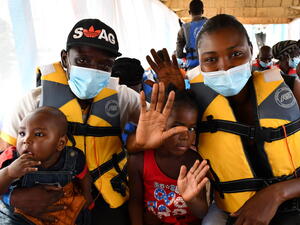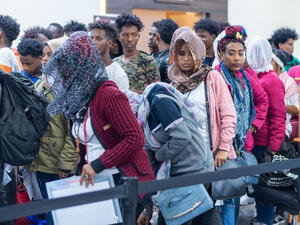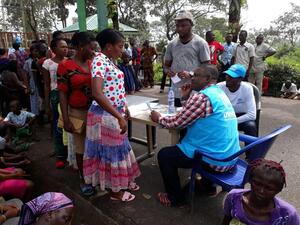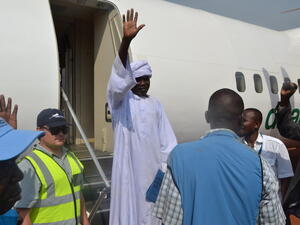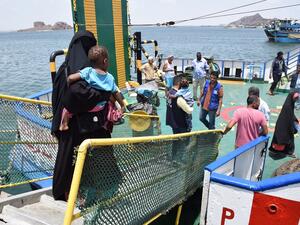Iris testing of returning Afghans passes 200,000 mark
Iris testing of returning Afghans passes 200,000 mark

Returning Afghans undergoing iris tests at the verification centre in Peshawar, Pakistan.
ISLAMABAD, Pakistan, Oct 10 (UNHCR) - More than 200,000 Afghans seeking repatriation assistance have been checked by a state-of-the-art iris recognition system since UNHCR introduced the technology a year ago to help detect anyone seeking the agency's standard repatriation package for a second time.
Meanwhile, UNHCR on Thursday saw its first convoy of nearly 200 Afghans return to their home villages in the north-western Badghis province after living for years as displaced persons in the south.
For Afghan refugees returning from Pakistan, the iris recognition technology - using biometric iris data unique to each eye - has helped UNHCR to detect anyone who has previously been "enrolled" in the database and is seeking assistance for a second time.
"This is the first time UNHCR has used such biometric checks," said Hasim Utkan, the agency's representative in Pakistan. "Although there was initial hesitation about how well it would work, it has proved very successful, meeting not only the cultural needs of the refugees but also the operational requirements of UNHCR."
Since a test project began last October in Peshawar, about 202,000 refugees seeking UNHCR help under the voluntary repatriation programme have been checked. Testing was carried out for the first months of this year on all returnees above the age of 12 - more than half of all refugees going home from Pakistan.
The age of those tested was lowered to six years in July to ensure that children were not being forced to make repeated trips with various adults - an abuse of the assistance programme and a danger to the children. About three-quarters of all returning refugees are now checked. Only those with physical impediments or who are too young to use the equipment are exempt.
This is the first field use of such iris technology anywhere in the world, and it has performed flawlessly despite harsh conditions in the heat and dust of Pakistan's border territories with Afghanistan. In addition to fixed locations, UNHCR has operated mobile units to ease the return of refugees from remote areas.
The actual test takes only a few seconds from when the returnee sits in front of the camera. Images of the iris, which appear on an adjoining computer screen, are transmitted to the computer server. The system converts the image into a digital code, which is then checked against the entire database from all iris centres to see if there is a duplicate.
If the code has not appeared before, the refugee is registered and given clearance to receive an assistance package on arrival in Afghanistan. Returnees are entitled to a travel grant that varies with the distance, food and some non-food items like shelter material.
If the test reveals that the refugee has been enrolled before - so far only about 1,000 have been found to be "recyclers" - the person is refused a second helping of assistance. Of the more than 73,000 families that UNHCR turned away last year at its registration centres, more than 22,000 families were found - through interviews and other verification methods - to have previously returned home and received the aid package. The new technology eases the job of refugee agency staff working at the centres.
"We feel very confident with this technology that the assistance is reaching those who really need the help of UNHCR to repatriate," said Utkan.
Fears that refugees might be intimidated by the technology have proved unfounded. Since only the eye is seen onscreen, few people have raised the traditional objection to photographing women's faces. Tests on women and children are done by female refugee agency workers.
Privacy is protected too. No information is recorded that can identify the individual tested: the code describing the iris has no link to the name, age, destination or anything else about the refugee.
The refugee agency now operates two iris verification centres in Pakistan on a Sunday-to-Thursday basis - in Quetta and Peshawar - with another at Ali Zai in Pakistan's border Tribal Areas that operates only on Monday.
In addition, both Peshawar and Quetta operate mobile teams that can test groups at the refugee camps to speed up their departures. An experimental iris testing verification centre operates in the city of Khost to see if the system can be operated in conditions inside Afghanistan.
UNHCR's voluntary repatriation programme runs until 2005, and iris testing will remain a key part of the verification process next year. Last year UNHCR helped more than 1.5 million Afghans go home from Pakistan - almost all before the introduction of iris checks - and returns this year have exceeded 320,000.
Meanwhile, the return on Thursday of 36 displaced Afghan families to their villages of origin in Morghab and Gormash areas in Badghis province aboard UNHCR's 11-vehicle convoy marked the first time the agency has helped internally displaced persons living in the southern Kandahar province to return to Badghis.
Most these families had fled their homes nearly two years ago in the wake of anti-Pashtun ethnic tensions that accompanied the fall of the Taliban government or due to the long drought in the region. In the south, they stayed in Zhare Dasht settlement or makeshift camps like Kandahar's "animal market". The returning families will receive agricultural kits (seeds, shovel, sickle, watering can), plastic sheets, tents, lanterns, soap, hygiene cloths, family kits from the UN Children's Fund (spoons, bucket, cups, soap, bowl and plates) and wheat flour from the World Food Programme.
Many more families have expressed their wish to return this year, but UNHCR could not facilitate their return while fighting continued in Badghis earlier this year. With tension between factions subsiding, and with lowering levels of harassment in the villages, as well as the easing of drought conditions, the refugee agency has begun helping many displaced people to return to Badghis province since summer, mainly from camps located in the neighbouring Herat province.
UNHCR hopes to continue with the voluntary return movement from the south to the north, but there are still specific areas in the north that the agency cannot recommend for return due to ongoing conflict between factions, or human rights abuses.
There are an estimated 220,000 internally displaced people in Afghanistan, including some 140,000 in the southern provinces.




